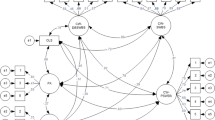Abstract
This paper is based on background research we undertook for UNICEF Innocenti Report Card 11 on child well-being in rich countries. It develops a new domain index of subjective well-being based on seven indicators drawn from the Health Behaviour of School Aged Children (HBSC) survey 2009/10, which includes life satisfaction, relationships with family and friends, well-being at school, and subjective health. It explores the associations between the indicators, components and the overall domain. Changes in subjective well-being between HBSC 2001/2 and 2009/10 are analysed. It then explores the relationships between subjective well-being and objective domains: material, health, education, behaviour and housing and environment. At a macro level subjective well-being is associated with all those domains. It concludes that subjective well-being should be included in comparative studies of well-being but not necessarily as just another domain. It is a related but different order measure.







Similar content being viewed by others
Notes
Keung (2007) used the British Household Panel to relate employment and educational outcomes at 20–24 to variation in subjective well-being when the cohort members were 11–15. Her results proved largely negative.
Young people were asked how often they had experienced the following symptoms in the last 6 months: headache; stomach ache; feeling low, irritable or bad tempered; feeling nervous; difficulties in getting to sleep; and feeling dizzy. Response options for each symptom ranged from “about every day” to “rarely or never”. The findings presented show the proportions who reported multiple (two or more) health complaints more than once a week in the past 6 months.
References
Bradshaw, J., Hoelscher, P., & Richardson, D. (2007). An index of child well-being in the European Union 25. Social Indicators Research, 80, 133–177.
Cantril, H. (1965). The patterns of human concern. New Brunswick: Rutgers University Press.
Cummins, R. (2010). Subjective well-being, homeostatically protected mood and depression: a synthesis. Journal of Happiness Studies, 1(1), 1–17.
Currie, C., Zanotti, C., Morgan, A., et al. (2012). Social determinants of health and well-being among young people. Health Behaviour in School-aged Children (HBSC) study: International report from the 2009/2010 survey. Copenhagen: World Health Organisation.
Diener, E., Oishi, S., & Lucas, R. E. (2003). Personality, culture, and subjective well-being: emotional and cognitive evaluations of life. Annual Review of Psychology, 54, 403–425.
Huebner, E. S., Suldo, S. M., Smith, L. C., & McKnight, C. G. (2004). Life satisfaction in children and youth: empirical foundations and implications for school psychologists [Special issue]. Psychology in the Schools, 41, 81–93.
Keung, A. (2007). The impact of life events on the subjective well-being of young people: Evidence from the British Household Panel Survey, PhD University of York.
OECD (2013). http://www.oecd.org/pisa/pisaproducts. Accessed 2 April 2013.
Redmond, G. (2011). Fullest potential? Three approaches to analysing the adequacy of children’s living standards for their development, Conference of the Human Development and Capabilities Association, Den Haag, 5–8 September 2011.
Redmond, G. (2012). A method for assessing the adequacy of Australian Children’s living standards. In K. Gelber & F. Panzironi (Eds.), The capability approach in the Asia-Pacific region. London: Routledge.
Ridge, T. (2002). Child poverty and social exclusion. Bristol: The Policy Press.
Stiglitz, J., Sen, A. & Fitoussi, J.-P. (2009). Report of the commission on the measurement of economic performance and social progress. http://www.stiglitz-sen-fitoussi.fr/documents/rapport_anglais.pdf.
The Children’s Society (2012). The good childhood report 2012: A review of our children’s well-being, http://www.childrenssociety.org.uk/sites/default/files/tcs/good_childhood_report_2012_final.pdf.
UNICEF. (2007). Child poverty in perspective: An overview of child well-being in rich countries, Inncocenti Report Card 7. Florence: UNICEF.
UNICEF Office of Research. (2013). Measuring child well-being in rich countries: A comparative overview, Innocenti Report Card 11. Florence: UNICEF Office of Research.
Author information
Authors and Affiliations
Corresponding author
Rights and permissions
About this article
Cite this article
Bradshaw, J., Martorano, B., Natali, L. et al. Children’s Subjective Well-Being in Rich Countries. Child Ind Res 6, 619–635 (2013). https://doi.org/10.1007/s12187-013-9196-4
Accepted:
Published:
Issue Date:
DOI: https://doi.org/10.1007/s12187-013-9196-4




